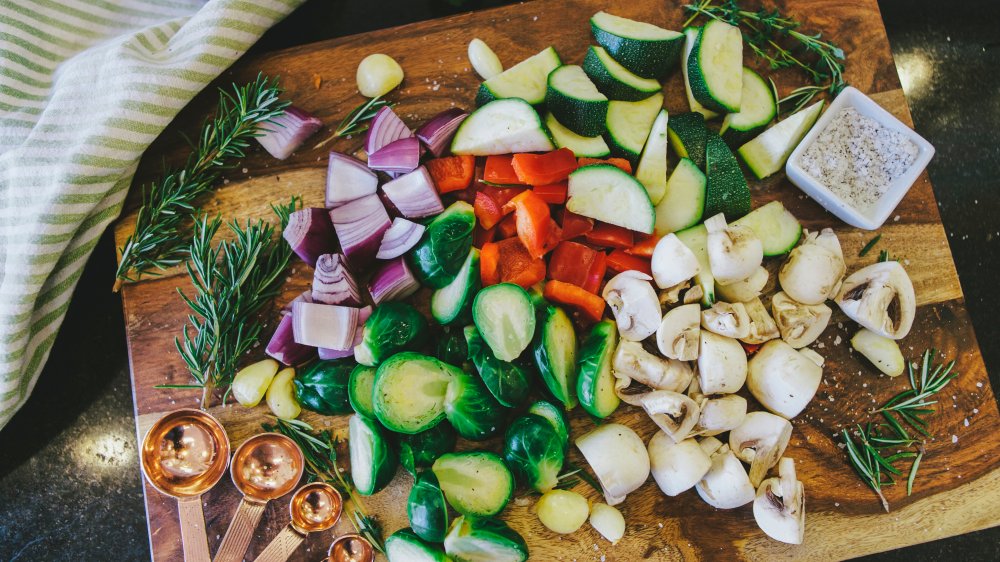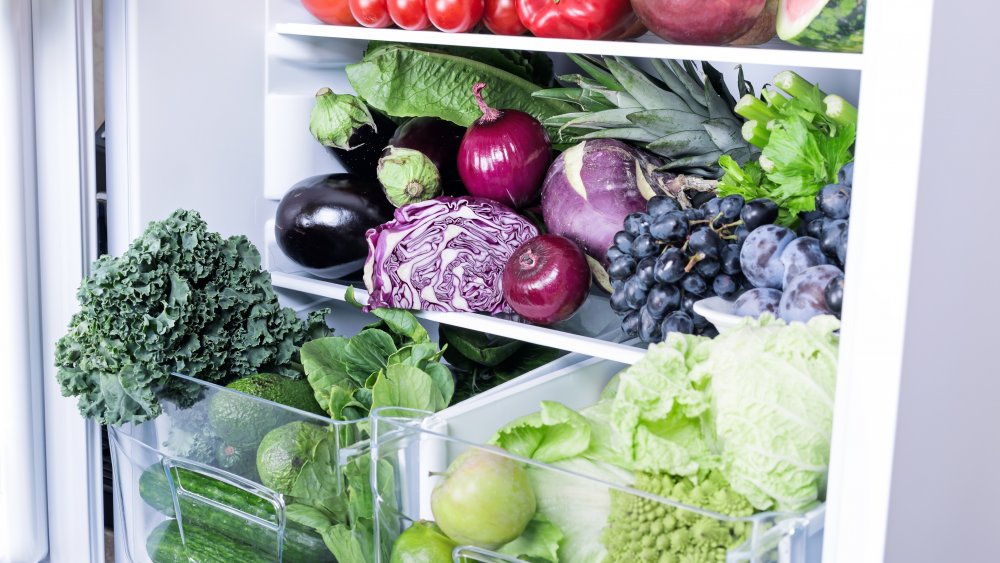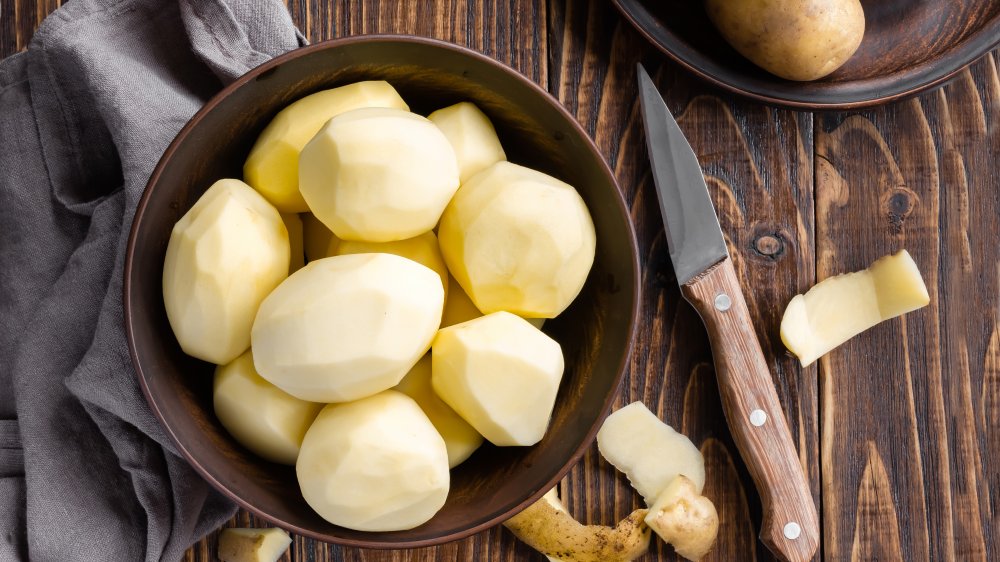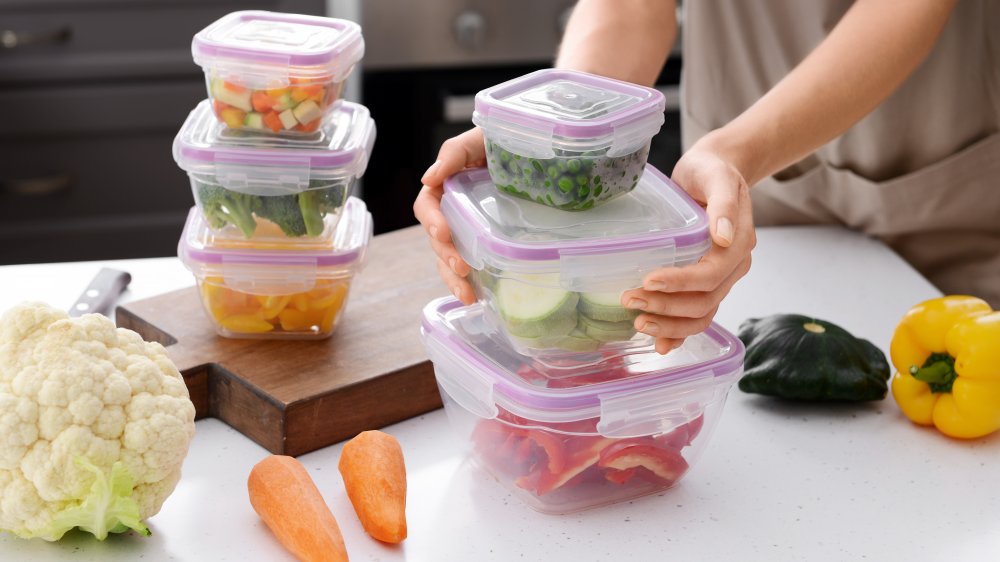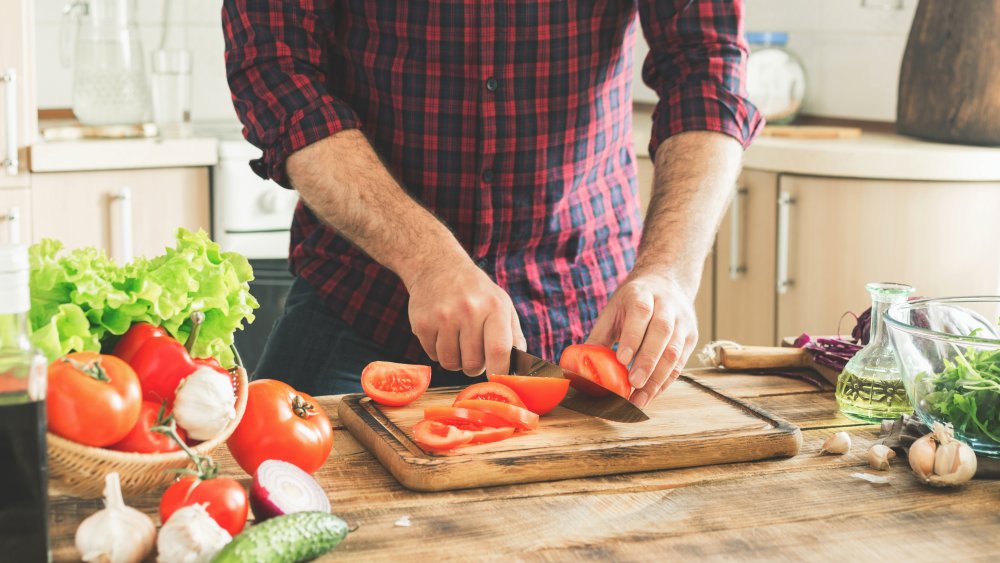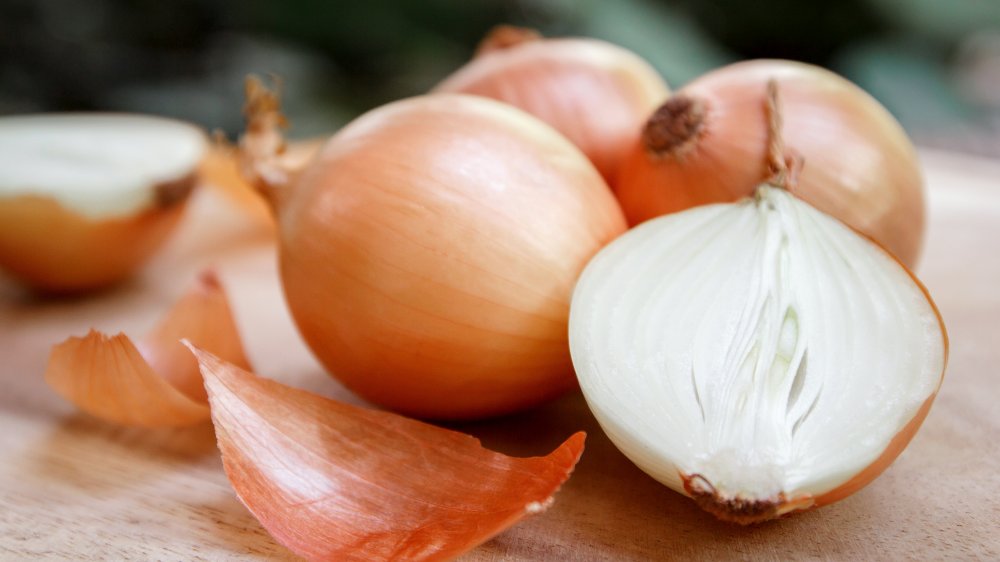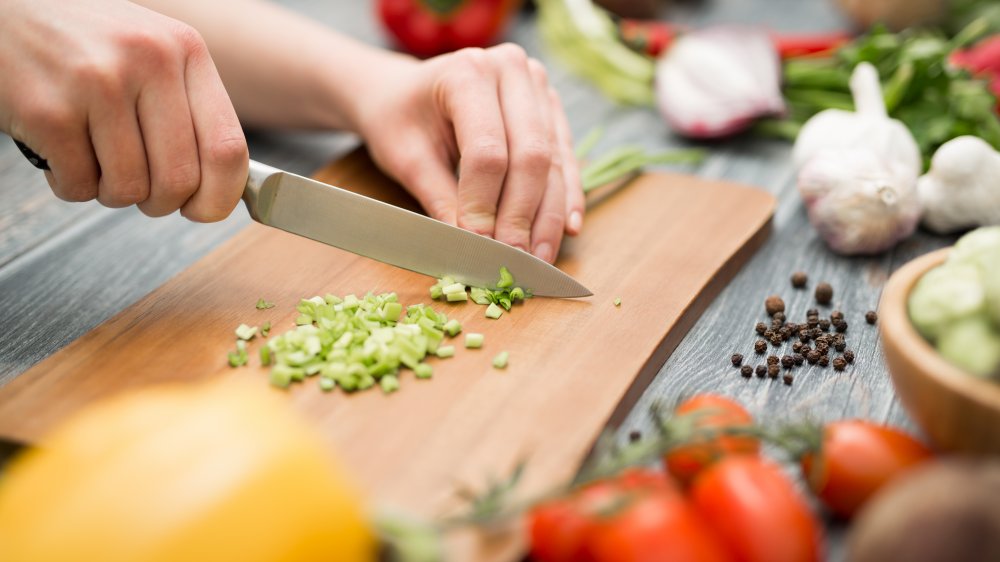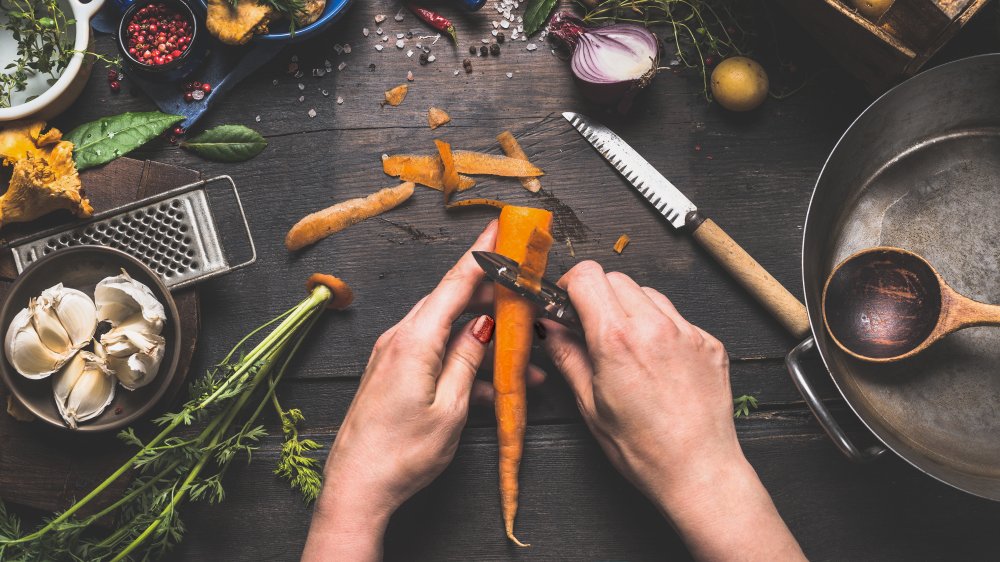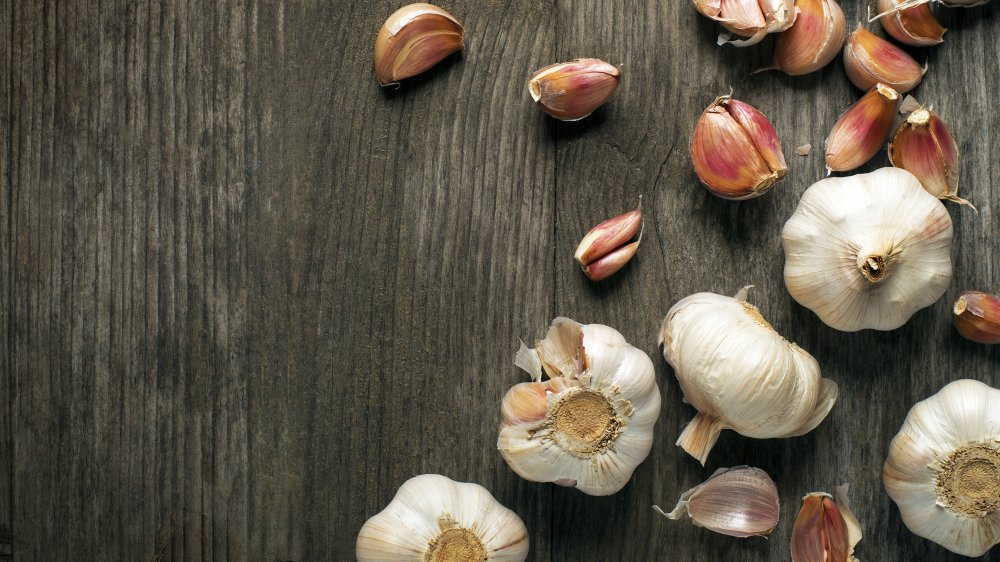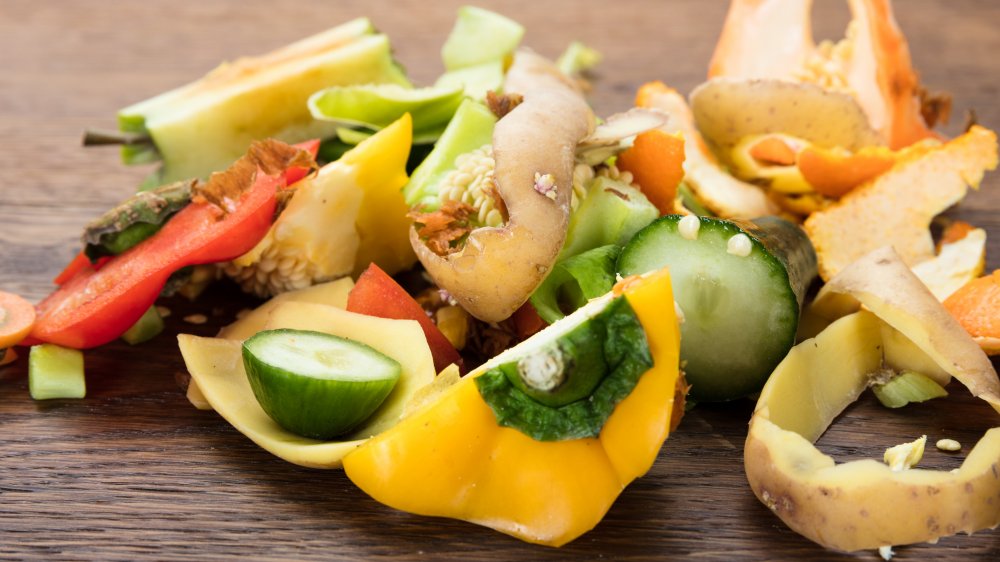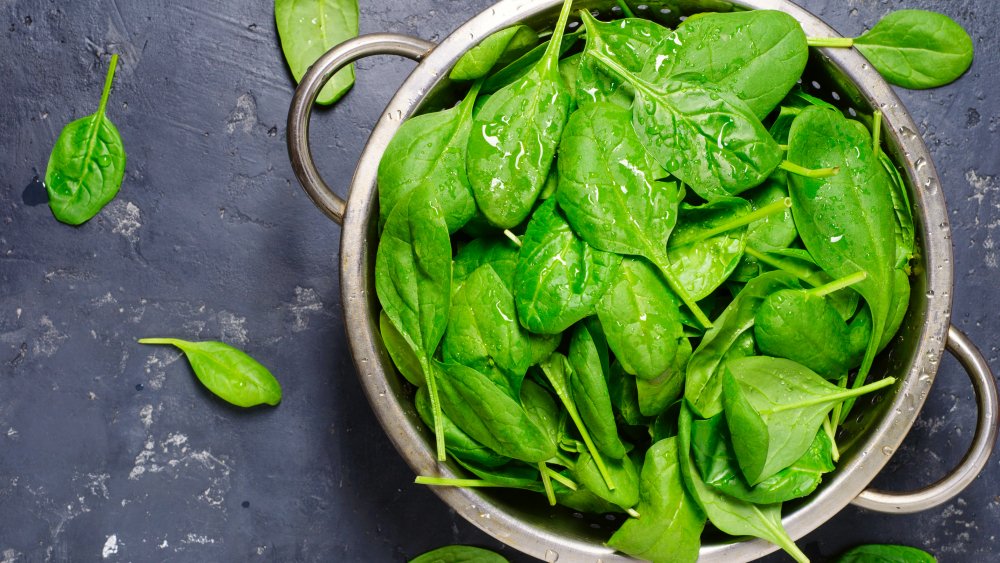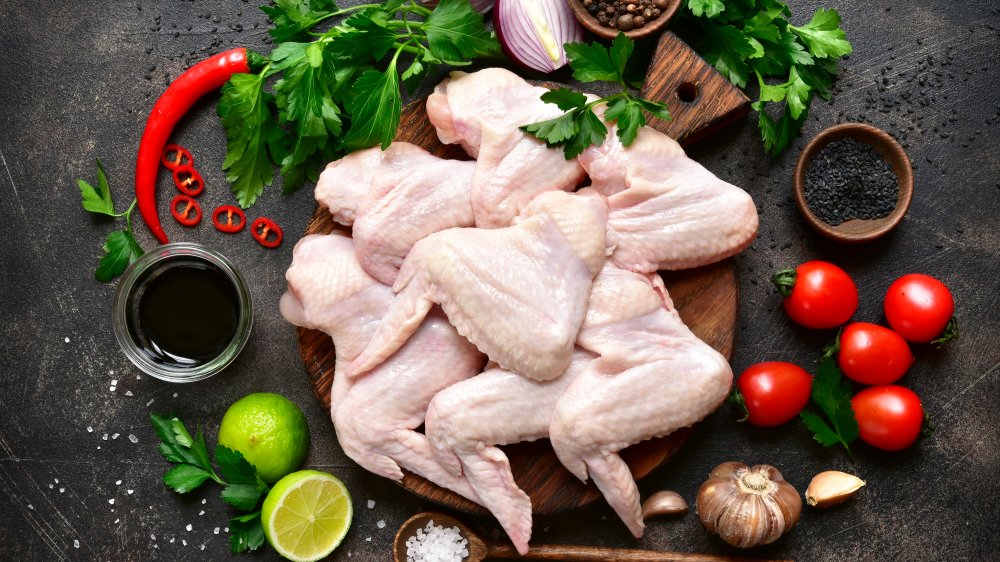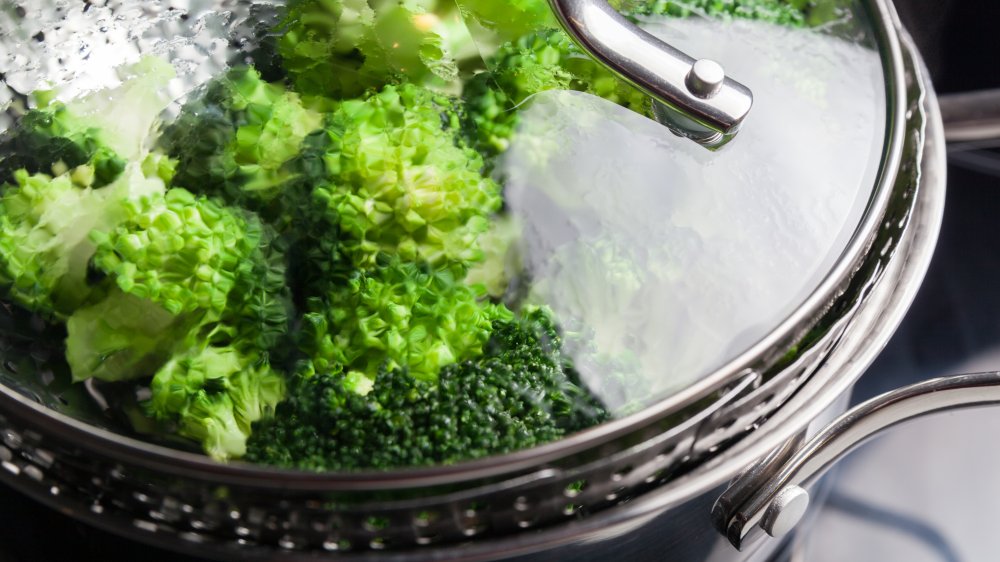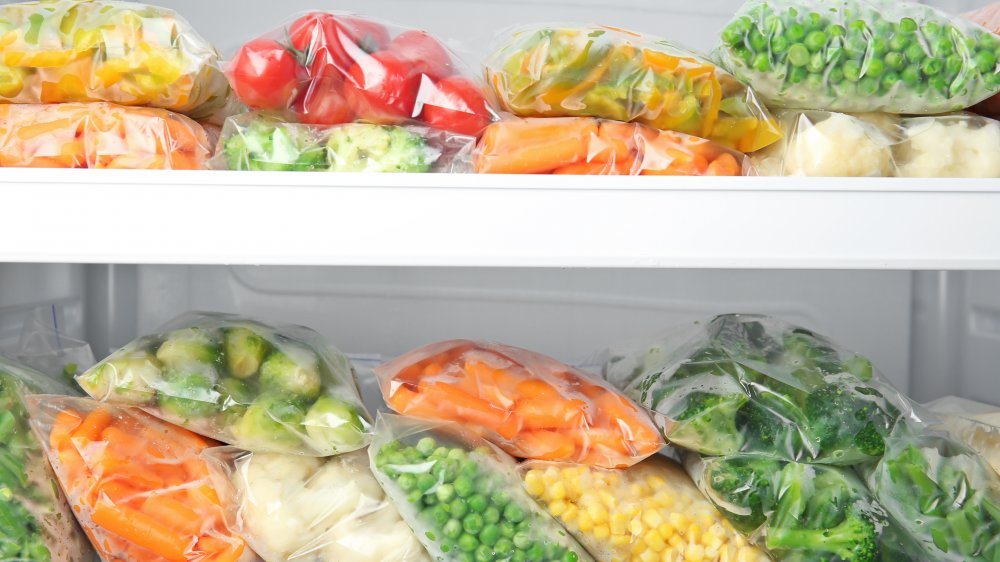Mistakes Everyone Makes When Prepping Vegetables
Whether you're a lifelong vegetable lover or new to plant-based cooking, one thing is certain: Vegetables can be a pain to prep. Veggies bought at a farmers market or obtained through a CSA can be a little unwieldy. They might be available in unfamiliar forms, like carrots or beets that have their wild green tops still attached. It's not just the market, either. The grocery store is filled with things like bulk greens or bunched radishes that need a little more love than packaged items like bagged spinach, coleslaw-ready shredded carrots, or prewashed salad mix. If you're new to vegetable prep, you might not know that you're throwing away stuff you could be using, or that you're removing the most nutritious part of the vegetable.
The good news is that these skills are super easy to learn. All you need is a little practice with a knife and to look out for these mistakes everyone makes when prepping veggies. Before you know it, you'll be well on your way to becoming a master prep cook. You'll save money by preserving every last scrap for making stock, and your fridge will be perfectly organized to maximize the shelf life of your investment. Not only that, but your fruits and vegetables will be more nutrient-dense and taste better, too.
Not storing vegetables correctly
Buying vegetables in bulk can be a great way to save money on produce. If you shop for fruits and vegetables at stores like Costco, you may not have a choice — nothing there comes in small packages! But you have to be prepared for long-term storage when buying large bags of potatoes, onions, apples, avocados, and more. Potatoes and onions, for example, can last over a month if they're stored in a cool, dark space, but you should never store them together. The onions release gasses that cause the potatoes to sprout, spoiling them faster. The same thing goes for apples: They release ethylene gas that causes other fruits and vegetables to ripen faster, so you'll want to store them away from other produce to keep the apples from ruining the bunch.
When it comes to refrigerated vegetables, wrapping vegetables like kale, broccoli, carrots, and celery in a plastic bag will extend their shelf life. Storing them in the crisper bin will buy you an extra week, or more. Mushrooms, on the other hand, do better in the dry environment of a paper bag, so keep them out of the crisper bin. Finally, if you get your root vegetables with their greens attached (like carrots, radish, turnips, and beets), be sure to remove the green tops before putting them in the fridge. The tops are edible, but they will suck nutrients and moisture out of the roots, leaving you with sad, limp carrots.
Letting fruits or vegetables oxidize
Preparing for the week by chopping your fruits and vegetables in advance is a great way to save time, but it might not be the best way to preserve the vegetable's flavor and color. It's not a problem with antioxidant-rich fruits and vegetables, like berries, kale, broccoli, or beets. These items are protected from oxidizing, and they won't change color when you cut into them.
The same can't be said for items like potatoes, apples, bananas, eggplant, parsnips, taro root, celery root, and avocados. As soon as they're cut, the exposed surface begins to turn brown. You can limit the browning by brushing the cut surface with citrus juice, or you can try placing cut vegetables in water and fruit in acidulated water (water mixed with citric acid, citrus juice, or vinegar). But, the best way to prevent your fruits and vegetables from oxidizing is to keep their insides away from oxygen in the first place. Keep them whole until just before you plan to cook or consume them.
Meal-prepping veggies too early
Oxidation isn't the only problem you have to worry about when cutting fruits and vegetables for meal prepping. Cutting produce too early can cause a loss of nutrients and overall quality, as well. According to Verywell Fit, nutrient loss is caused by oxygen, light, and heat. Fruits and vegetables are naturally protected from the first two factors — before they're cut, that is. Once the insides are exposed, the vitamins start to break down. Vitamin C is especially susceptible, as it can leak out in fluids when you cut produce.
Cutting vegetables can also increase their risk of spoilage. It turns out that fruits and vegetables continue to breathe after they're harvested. Cutting into them changes the rate at which they breathe and releases carbon dioxide. In excess, that gas can change the flavor and texture of the cut food. That's a good reason to buy whole fruits and vegetables and avoid the pre-cut vegetable options in the grocery store, too; it's just not worth the time savings.
Cutting vegetables into random sizes
It might seem tedious to spend the time it takes to cut vegetables into perfectly uniform pieces, but it's really quite important. At culinary school, student's knife skills are constantly assessed, and it's not just because the instructors want the finished dishes to look prettier. Uniform shapes cook more evenly than randomly sized pieces. This applies to vegetables cooked in a skillet on the stovetop as well as sheet pan baked vegetables. Anything cut into very small pieces (like a mince, small dice, brunoise) will cook more quickly than larger cuts (like a large dice or cube). If you were to toss both sizes together, the tiny pieces would burn by the time the larger pieces cooked through.
The only reason to cut vegetables into dissimilar sizes is if it's purposeful. It can work to your advantage with cooking methods like sheet pan dinners, for example. Cutting longer-cooking items like sweet potatoes into a small dice while leaving broccoli in large florets would ensure that they cook at a similar rate. But, for most meals, it's best to concentrate on your knife cuts when prepping vegetables.
Trying to cut round vegetables without making a flat surface
Round vegetables are the most dangerous item in the kitchen for beginner cooks. It's oh-so-easy for fruits and vegetables to roll around on the cutting board. If you've already committed to making a cut before you noticed the roll, that could spell disaster for your exposed fingers. The best way to cut produce while protecting your hands is to hold the cut food properly and create a flat surface for cutting.
For starters, you should always protect your fingers by using what's called the claw grip. Curl the fingers of your non-cutting hand so your thumb is tucked behind your fingers and the knife's blade sits flat against your knuckles. Move the claw backward with the knife as you slice, holding the vegetable steady without exposing your fingertips to the blade. To keep the vegetable from rolling around, try to create a flat surface on one side. For example, with round items like potatoes, you can start by slicing off a strip of potato. When you turn the potato onto the cut side, you'll find it now sits on a flat surface and it's so much easier to cut.
Using the wrong knife or a dull knife
If you have a chef's knife, you might think it's the right tool for any chopping, slicing, or dicing task. But there are several different types of knives out there for a good reason: Each blade is particularly well-suited for a specific task. Instead of using a large knife to cut everything, try using shorter knives like santoku knives or Japanese vegetable knives. You can also look to a paring knife for small tasks like segmenting oranges or peeling apples and potatoes. Longer utility knives are great for chopping shallots or mincing garlic, and the serrated versions are perfect for thinly slicing tomatoes.
More important than using the right knife is using a sharp knife. Some people say they're scared of sharp knives, but there's really nothing scarier in the kitchen than a dull knife. Dull blades require more pressure to use, and the University of Rochester Medical Center warns that they don't grip the surface of the food they're cutting, so they can slip more easily.
Getting rid of vegetable's nutrient-dense skins, stems, and tops
Of course, some peels are inedible (we're looking at you, bananas and avocados), but you might want to think twice before peeling vegetables like carrots, cucumber, potatoes, or ginger. You might be throwing away the most nutrient-rich parts of the vegetable! In general, the peels contain the highest concentration of vitamins, minerals, and antioxidants, and as much as 30 percent of a vegetable's fiber can be found in the peels. That fiber is not only good for your digestive health, but it can also increase satiety and help you feel fuller for longer.
It's not just the peels, either: The stems and leafy tops often contain more nutrients than the vegetable itself. Instead of throwing away vegetable tops, try to repurpose them into a part of your dish. You can use carrot tops to make pesto or chimichurri, and beet and turnip greens create a delicious sauteed greens side dish. Even broccoli stems are delicious — you can chop them up and add them to stir-fries, shred them for coleslaw, or simmer them in cream and puree them to create a full-flavored broccoli soup.
Peeling fruits and vegetables the wrong way
If you do decide to peel fruits and vegetables, make sure you're using the most efficient peeling method. Peeling incorrectly not only wastes valuable, edible product, but it also wastes your time. For many tasks, a vegetable peeler works best. It makes quick work of removing the skins from potatoes, carrots, and cucumber, and you can also use it to remove the fibrous strands from celery. A vegetable peeler also works exceptionally well for removing the skin from mangoes, but it's not the best tool for every task.
A vegetable peeler is overkill when it comes to thin-skinned foods, like garlic and ginger. There are several ways to peel garlic, including crushing it with the butt of your knife or shaking the cloves between two metal bowls. And ginger skin slips right off with the stroke of a regular spoon. When it comes to tough-skinned veggies like butternut squash, it turns out the microwave can help. After about three minutes in the microwave, the skin easily peels off with a paring knife.
Wasting vegetable parts that can still be used
Try not to let things like vegetable peels, woody stems, or wilted green tops go to waste. Those parts might not make it into your dinner, but they could certainly be repurposed to create an essential building block of a great meal: Vegetable stock. Homemade broth is one of those things that separates a good cook from a great one. It can add an incredible level of depth and flavor to soups, sauces, casseroles, and more.
Making vegetable stock is easy, especially if you have a freezer full of veggie discards. The Kitchn advises to avoid using scraps from veggies with overpowering flavors, like cabbage, broccoli, beets, artichokes, and cabbage, along with anything that's spoiling or rotten. But most vegetables are fair game. You can use peels, the inedible ends of carrots and onions, the woody ends of asparagus and mushrooms, stalks, roots, and stems. You can even save things like onion skins, which can add an appealing color to your stock. The easiest way to take advantage of scrap stock making is to keep a baggie handy when you're chopping vegetables. Store the bag in the freezer until you have about four cups of vegetables.
Not washing produce
Here's the thing with fruits and vegetables: They're dirty. Root vegetables like potatoes and carrots grow underground, but even above-ground produce like lettuce and tomatoes can be splattered with dirt and mud during the watering process. And anything that's not organically grown can contain pesticide residue, so it's really important to wash your produce before using it. Unless it's prewashed, that is; studies have shown that washing prewashed greens at home actually increases the likelihood of getting sick due to cross-contamination.
That doesn't mean you should wash your veggies as soon as you get home from the grocery store, though. Washing produce too early can actually promote bacterial growth that can speed up food's decay. It's really best to wait to wash fruits and vegetables just before consuming them. If you do have to wash them ahead of time, make sure they're as dry as possible before storing them. Excess moisture can also speed up food spoilage.
Contaminating your fruits and vegetables
It's super easy to contaminate fruits and vegetables by accident during food preparation. The U.S. Food and Drug Administration (FDA) says cross-contamination happens when ready-to-eat foods come in contact with unclean surfaces or utensils. Since these ingredients are never cooked, they're never exposed to the heat that kills most bacteria, leading to foodborne illness.
That's why it's super important to keep fruits and vegetables away from raw poultry, meat, and seafood, along with any cutting boards or knives that touched those products. If you have two sets of cutting boards — one for raw meats and one for vegetables — you'll minimize the risk of cross-contamination even further. It's also important to wash cutting boards and cooking utensils well with soap and hot water. If you're using nonporous cutting boards (like plastic), it's safest to clean them in the washing machine to remove any bacteria that may linger, although both plastic and wooden cutting boards can also be sanitized with bleach. Bamboo cutting boards might be best since they're more resistant to bacteria, so they can be cleaned with hot, soapy water.
Not cooking vegetables the right way
Every vegetable is full of vitamins, minerals, and antioxidants, but you might not be able to benefit from those nutrients if you don't cook them the right way. You see, some vegetables — like potatoes, mushrooms, spinach, asparagus, and Brussels sprouts — contain water-soluble vitamins, including vitamins B and C. Boiling these vegetables causes the vitamins to leach out into the cooking water. Unless you plan to consume the cooking water (as you would with soup), you'll miss out on these vitamins. Instead, it's better to steam or microwave these vegetables to keep the nutrients with the vegetable.
Fat-soluble vitamins A, D, E, and K, on the other hand, are actually more absorbable by the body when they're cooked in a fat. Cooking sweet potatoes, leafy greens like kale, broccoli, and cabbage in fat (as you would when you saute) makes the vegetables more nutrient-dense than they would be if they were cooked in water. If you do cook them with a moist cooking method like steaming, find a way to incorporate a fat into the dish, like by tossing these vegetables with butter, vinaigrette, or drizzling them with high-quality olive oil.
Freezing raw vegetables
If you're trying to extend the shelf life of your fruits and vegetables, the freezer is a great way to go. It's a great way to stop vegetables from spoiling, and it can also be an effective way to meal prep for later. There's no greater feeling than knowing that you have a bag of ready-to-use vegetables in the freezer for your favorite stir-fry recipe! Before you go crazy and toss the entire crisper bin in the freezer, there's something you need to know: Raw fruits and vegetables aren't something you should store in your freezer.
You'll want to blanch your vegetables in boiling water before hitting the freezer. This process sets the color of the vegetable, as well as preserving the vitamins and minerals. More importantly, it also stops enzyme activity that can affect the vegetable's flavor. Sadly, some veggies can't be frozen at all. Vegetables like cucumbers, cabbage, celery, and lettuce can't be blanched, and freezing raw would turn them limp and watery.
